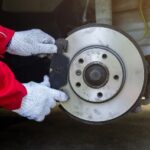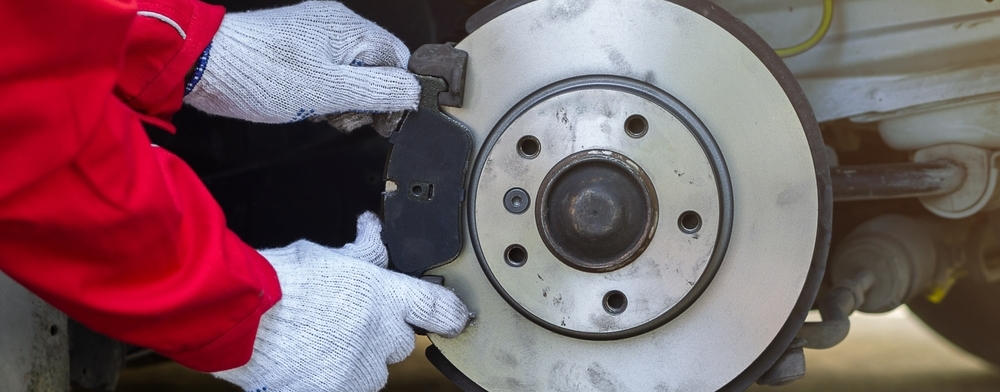 Have you ever heard the term ‘brake fade’ before? It refers to those instances when you need to stop quickly, but when you stomp on the brake pedal, it takes longer than it should for your car to stop. Yup, that unexpected and dangerous delay is brake fade. It can happen when you least expect it, and you need to know how to spot it and how to fix it. Let’s review how contaminated brake fluid and a spongy brake pedal warn of potential brake fade in your car’s braking system.
Have you ever heard the term ‘brake fade’ before? It refers to those instances when you need to stop quickly, but when you stomp on the brake pedal, it takes longer than it should for your car to stop. Yup, that unexpected and dangerous delay is brake fade. It can happen when you least expect it, and you need to know how to spot it and how to fix it. Let’s review how contaminated brake fluid and a spongy brake pedal warn of potential brake fade in your car’s braking system.
What Is Brake Fade?
Brake fade applies to situations when your brakes don’t respond instantly. You can usually feel brake fade in a spongy brake pedal and an increased stopping distance. Brake fade happens when the braking system components lack the friction required to slow and stop your vehicle. Without adequate friction, you may have to push harder on the brake pedal and for a longer time than usual.
Types Of Brake Fade
Vehicles using disc brakes rely on a braking system using calipers, pistons, brake pads, and rotors to stop. When the driver engages the brake pedal, the calipers and pistons push the brake pads against the rotating rotors. The friction generated by this braking action slows and eventually stops your vehicle. There are different types of brake fade, and they occur under the following circumstances.
Excess Heat Build-Up
Active braking generates heat. When the heat doesn’t have time to dissipate, like in stop-and-go traffic, your brakes may become less responsive. If this condition continues for a prolonged period, you may experience brake fade.
Contaminated Brake Fluid
When water contaminates your vehicle’s brake fluid, it lowers its boiling temperature. Under these circumstances, your brake fluid becomes less effective at heat management. As the brake fluid’s temperature increases, the water turns into steam, and the resulting air bubbles can contribute to brake fade. Contaminated brake fluid often produces a spongy brake pedal and an increased distance before stopping.
Green Fade or Worn Brake Pads
During the manufacturing process, gases are embedded within the brake pad material. These gases emerge when brake pads get too hot, creating a thin film between the pad and the rotor. This film reduces the friction necessary for successful braking. It’s similar to a hydroplaning vehicle on a wet road, except it’s the pads losing grip instead of the tires.
Glazing
When excessive braking generates too much heat, the resin in the brake pads actually melts. Over time, this overheating and cooling back down creates a hard, smooth surface on the pads. This glazed surface reduces friction between the pads and rotors – so your car takes longer to slow down and stop.
How Can I Avoid Brake Fade?
Preventing brake fade mainly involves routine maintenance of your braking system and adjusting your driving style. The following suggestions can reduce the severity and frequency of brake fade.
Perform Routine Maintenance
Braking System Inspection
During a brake inspection, the technician looks at all the components within your vehicle’s braking system. They check for wear, damage, and faulty parts. They check the brake fluid levels and look for leaks. This inspection is vital for vehicle safety, and you must schedule it regularly. Read your owner’s manual for your vehicle’s factory-recommended braking system service schedule.
Brake Fluid Flush
Since brake fluid is hygroscopic, common brake fluids can absorb up to 2% moisture content in a 12-month period. The wet boiling point threshold of brake fluid is 3.7%, and in certain circumstances, it can occur in fewer than 24 months. Achieving that much water in your vehicle’s brake fluid doesn’t guarantee brake fade but increases the likelihood. Scheduling routine brake fluid inspections will track its moisture content and viability. A brake fluid flush service drains and replaces the contaminated fluid with fresh.
Purchase Quality Replacement Parts
During routine maintenance, ask for quality replacement parts. Brake pads, rotors, and calipers should be factory-recommended parts, not the cheapest knock-off products you can find. Cheaply made parts can cost you more in the long run due to safety, longevity, and poor-quality issues.
Limit Heavy Towing
Towing items near or over your vehicle’s weight restriction can quickly overheat your braking system. Try to stay under the factory-recommended towing limitations and use low gears when driving down hilly terrain. Avoid ‘riding the brakes’ and pull over to let things cool down when necessary.
Avoid Aggressive Driving
Speeding, frequent lane changes, and forceful braking all contribute to more wear and tear on your vehicle’s braking system. Driving aggressively wastes fuel and heats up your brakes very quickly. This behavior on a long drive can certainly cause brake fade and may lead to a collision. Avoid aggressive driving behaviors and opt for intuitive driving instead. Allow your car’s momentum to carry it down the road and only speed up (use the accelerator) or slow down (use the brakes) to stay with the general traffic flow.
How To Fix Brake Fade Issues
Sometimes, all it takes to fix brake fade is waiting for the brakes to cool down. However, if the pads, rotors, or calipers are melted, warped, or heat-damaged, replacement parts will be necessary. Consult a brake specialist, like Fisher’s Auto Service, in Kirkland, WA, for all your braking system needs. Our qualified technicians will inspect all your vehicle’s brake components and provide an easy-to-understand, detailed report. We will determine the cause of your vehicle’s spongy brake pedal, whether it’s contaminated brake fluid or faulty calipers.
Schedule Braking System Service
Schedule an appointment with Fisher’s Auto Service today for your brake inspection. Call us at (425) 655-1549 or visit us online to book a day and time that works for you. We look forward to seeing you!

